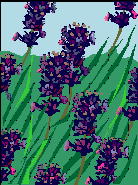Tom Wajda
Adams County Master Gardner
 My wife, Madeline, and I have
just returned from the North American Lavender Growers
Conference and the Sequim Lavender Festival both held
in Sequim, Washington. The Sequim Valley lies on the
northeastern edge of the Olympic Peninsula, some 90
minutes west of Seattle. Due to the Olympic Range,
Sequim is in a "rain shadow" receiving 20 inches or
less of rain per year.
My wife, Madeline, and I have
just returned from the North American Lavender Growers
Conference and the Sequim Lavender Festival both held
in Sequim, Washington. The Sequim Valley lies on the
northeastern edge of the Olympic Peninsula, some 90
minutes west of Seattle. Due to the Olympic Range,
Sequim is in a "rain shadow" receiving 20 inches or
less of rain per year.
Thirty years ago, the focus of
Sequim Valley agriculture was on dairy production;
today, there are only a few herds left, and Sequim has
become the lavender capital of the U.S. with several
hundred acres in production. While this is nowhere
near the level of lavender cultivation in France,
China, or even New Zealand, the fact remains that
relatively small farms (5-20 acres) can provide
sufficient income to support a small family. Thus,
lavender should be considered as an option for farmers
looking for alternatives to their present crops.
More than three quarters of
Sequim’s lavender production is distilled into oils
and sold on the international market; prices vary from
about $30.00 to $49.50 per liter (1.1 quarts)
depending on the type and quality of the oil. Oil
production per acre varies greatly with the genus of
lavender being grown. For example, Lavandula x.
intermedia ‘Grosso’, produces 76 liters per acre in
Sequim while L. angustifolia ‘Maillette’ produces only
16 liters per acre. Although the angustifolia oil
harvest is much lower that that of the intermedia, the
angustifolia oil, used in fine perfumes, commands a
premium on the world market.
 Lavender
is also sold as a dried product either in bunches or
as lavender buds. Both are used in crafting; lavender
buds are also used for culinary purposes where the
flavor of organically grown angustifolias is
preferred. A major drawback in the production of dried
lavender is the amount of hand harvesting required to
produce quality bunches of flowers or dried lavender
buds.
Lavender
is also sold as a dried product either in bunches or
as lavender buds. Both are used in crafting; lavender
buds are also used for culinary purposes where the
flavor of organically grown angustifolias is
preferred. A major drawback in the production of dried
lavender is the amount of hand harvesting required to
produce quality bunches of flowers or dried lavender
buds.
One of the major "sales" items
connected with lavender is agritourism. The July 14-16
Sequim Lavender Festival brought in an estimated
35,000 attendees and $2,000,000 to the town; this in a
region some 90 minutes by road and ferry from Seattle.
Nearly 150 vendors were set up in the town and at the
eight farms on the tour.
Lavender requires three
essential elements for good growth – full sun, good
drainage, and a pH of 7.0-7.5. Ideally, it should be
planted on a south-facing slope. Good drainage is
critical as lavender does not require a great deal of
water. In France, it grows well with about 20 inches
of rain a year – about half the amount we get in the
mid-state region. Moreover, while lavender is not
subject to too many diseases, it can be affected by
mildews and fungi brought about by hot, humid
conditions.
Washington State University
has been very supportive of the move from dairy to
lavender for the farmers of the Sequim Valley. Curtis
Bues, Washington State University Extension Director
for the Sequim area, has written a handy 28 page guide
for the commercial farmer entitled Growing and
Marketing Lavender. Copies may be obtained from the
WSU Bulletin office at 800-723-1763 or online at
http://pubs.wsu.edu. Virginia McNaughton’s The
Grower’s Guide to Lavender and Ellen Spector Platt’s
Lavender: How to Grow and Use the Fragrant Herb are
both extremely informative and useful.
Read other articles on growing herbs or vegetables
Read other gardening articles by Tom Wajda